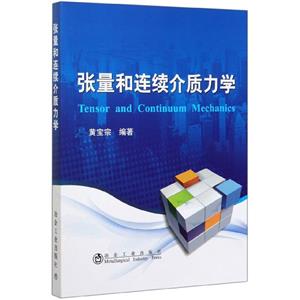
作者:(美)达夫莫斯(Constantine
页数:338
出版社:世界图书出版公司
出版日期:2015
ISBN:9787510084461
电子书格式:pdf/epub/txt
内容简介
本书是第三版,较第二版做了全面修订,增加了大量应用实例;包括了从1800年-1957年早期历史的一个全新详述;并新增一章重述了经典动力学中的开放问题最新解。参考文献由超过1500篇。内容囊括了存在性、唯一性、连续依赖性、熵解的大量性质、标度守恒律、和普通的双曲系统等。本书被称为是研究双曲守恒律的圣经。
目次:平衡率;连续物理学导论;守恒律的双曲系统;柯西问题;熵解和经典解的稳定性;标度守恒律的L1理论;一维空间守恒律的双曲系统;容许冲击;黎曼问题;一般性质;非线性标度守恒律;双守恒律的非线性系统;随机选择方法;向前追踪法和标准黎曼半群;通过粘性消失法构造BV解;补偿列紧理论;二维空间的守恒律。
读者对象:数学、力学、物理专业的学生和老师。
作者简介
Constantine M. Dafermos是国际知名学者,在数学和物理学界享有盛誉。本书凝聚了作者多年科研和教学成果,适用于科研工作者、高校教师和研究生。
本书特色
本书是第三版,较第二版做了全面修订,增加了大量应用实例;包括了从1800年-1957年早期历史的一个全新详述;并新增一章重述了经典动力学中的开放问题最新解。参考文献由超过1500篇。内容囊括了存在性、唯一性、连续依赖性、熵解的大量性质、标度守恒律、和普通的双曲系统等。本书被称为是研究双曲守恒律的圣经。
目次:平衡率;连续物理学导论;守恒律的双曲系统;柯西问题;熵解和经典解的稳定性;标度守恒律的l1理论;一维空间守恒律的双曲系统;容许冲击;黎曼问题;一般性质;非线性标度守恒律;双守恒律的非线性系统;随机选择方法;向前追踪法和标准黎曼半群;通过粘性消失法构造bv解;补偿列紧理论;二维空间的守恒律。
读者对象:数学、力学、物理专业的学生和老师。
目录
8.4 The Liu Shock Admissibility Criterion 8.5 The Entropy Shock Admissibility Criterion 8.6 Viscous Shock Profiles 8.7 Nonconservative Shocks 8.8 NotesⅨ Admissible Wave Fans and the Riemann Problem 9.1 Self-Similar Solutions and the Riemann Problem 9.2 Wave Fan Admissibility Criteria 9.3 Solution of the Riemann Problem via Wave Curves 9.4 Systems with Genuinely Nonlinear or Linearly Degenerate Characteristic Families 9.5 General Strictly Hyperbolic Systems 9.6 Failure of Existence or Uniqueness; Delta Shocks and Transitional Waves 9.7 The Entropy Rate Admissibility Criterion 9.8 Viscous Wave Fans 9.9 Interaction of Wave Fans 9.10 Breakdown of Weak Solutions 9.11 NotesⅩ Generalized Characteristics 10.1 BV Solutions 10.2 Generalized Characteristics 10.3 Extremal Backward Characteristics 10.4 NotesⅪ Genuinely Nonlinear Scalar Conservation Laws 11.1 Admissible BV Solutions and Generalized Characteristics 11.2 The Spreading of Rarefaction Waves 11.3 Regularity of Solutions 11.4 Divides, Invariants and the Lax Formula 11.5 Decay of Solutions Induced by Entropy Dissipation 11.6 Spreading of Characteristics and Development of N-Waves 11.7 Confinement of Characteristics and Formation of Saw-toothed Profiles 11.8 Comparison Theorems and L1 Stability 11.9 Genuinely Nonlinear Scalar Balance Laws 11.10 Balance Laws with Linear Excitation 11.11 An Inhomogeneous Conservation Law 11.12 NotesXII Genuinely Nonlinear Systems of Two Conservation Laws 12.1 Notation and Assumptions 12.2 Entropy-Entropy Flux Pairs and the Hodograph Transformation 12.3 Local Structure of Solutions 12.4 Propagation of Riemann Invariants Along Extremal Backward Characteristics 12.5 Boundson Solutions 12.6 Spreading of Rarefaction Waves 12.7 Regularity of Solutions 12.8 Initial Datain LI 12.9 Initial Data with Compact Support 12.10 Periodic Solutions 12.11 NotesXIII The Random Choice Method 13.1 The Construction Scheme 13.2 Compactness and Consistency 13.3 Wave Interactions, Approximate Conservation Laws and Approximate Characteristics in Genuinely Nonlinear Systems 13.4 The Glimm Functional for Genuinely Nonlinear Systems 13.5 Bounds on the Total Variation for Genuinely Nonlinear Systems 13.6 Bounds on the Supremum for Genuinely Nonlinear Systems …
13.7 General Systems 13.8 Wave Tracing 13.9 lnhomogeneous Systems of Balance Laws 13.10 NotesXIV The Front Tracking Method and Standard Riemann Semigroups..
14.1 Front Tracking for Scalar Conservation Laws 14.2 Front Tracking for Genuinely Nonlinear Systems of Conservation Laws 14.3 The Global Wave Pattern 14.4 Approximate Solutions 14.5 Bounds on the Total Variation 14.6 Bounds on the Combined Strength of Pseudoshocks 14.7 Compactness and Consistency 14.8 Continuous Dependence on Initial Data 14.9 The Standard Riemann Semigroup 14.10 Uniqueness of Solutions 14.11 Continuous Glimm Functionals, Spreading of Rarefaction Waves, and Structure of Solutions 14.12 Stability of Strong Waves 14.13 NotesXV Construction of BV Solutions by the Vanishing Viscosity Method 15.1 The Main Result 15.2 Road Map to the Proof of Theorem 15.1.1 15.3 The Effects of Diffusion 15.4 Decomposition into Viscous Traveling Waves 15.5 Transversal Wave Interactions 15.6 Interaction of Waves of the Same Family 15.7 Energy Estimates 15.8 Stability Estimates 15.9 NotesXVI Compensated Compactness 16.1 The Young Measure 16.2 Compensated Compactness and the div-curl Lemma 16.3 Measure-Valued Solutions for Systems of Conservation Laws and Compensated Compactness 16.4 Scalar Conservation Laws 16.5 A Relaxation Scheme for Scalar Conservation Laws 16.6 Genuinely Nonlinear Systems of Two Conservation Laws …
16.7 The System of Isentropic Elasticity 16.8 The System of Isentropic Gas Dynamics 16.9 NotesXVII Conservation Laws in Two Space Dimensions 17.1 Self-Similar Solutions for Multidimensional Scalar Conservation Laws 17.2 Steady Planar Isentropic Gas Flow 17.3 Self-Similar Planar Irrotational Isentropic Gas Flow 17.4 Supersonic Isentropic Gas Flow Past a Ramp of Gentle Slope 17.5 Regular Shock Reflection on a Wall 17.6 Shock Collision with a Steep Ramp 17.7 NotesBibliographyAuthor IndexSubject Index















